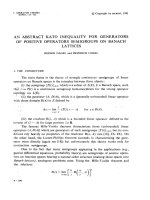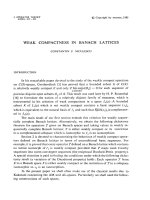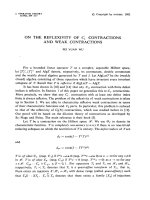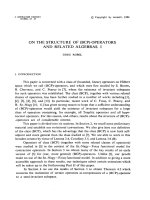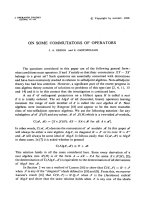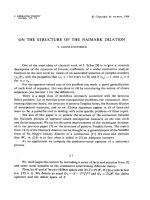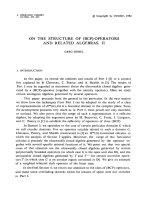Báo cáo toán học: "On Universal Cycles of Labeled Graphs" ppt
Bạn đang xem bản rút gọn của tài liệu. Xem và tải ngay bản đầy đủ của tài liệu tại đây (554.36 KB, 9 trang )
On Universal Cycles of Labeled Graphs
Greg Brockman
Harvard University
Cambridge, MA 02138
United States
Bill Kay
University of South Carolina
Columbia, SC 29208
United States
Emma E. Snively
Rose-Hulman Institute of Technology
Terre Haute, IN 47803
United States
snive lee@rose -hulman.edu
Submitted: Aug 26, 2008; Accepted: Dec 14, 2009; Published: Jan 5, 2010
Mathematics Subject Classification: 05C30
Abstract
A universal cycle is a compact listing of a class of combinatorial objects. In
this paper, we prove the existence of universal cycles of classes of labeled graphs,
including simple graphs, trees, graphs with m edges, graphs with loops, graphs
with multiple edges (with up to m duplications of each edge), directed graphs,
hypergraphs, and k-uniform hypergraphs.
1 Introduction
A simple example of a universal cycle (U-cycle) is the cyclic string 11101000, which
contains eve ry 3-letter word on a binary alphabet precisely once. We obtain these words
by taking substrings of length 3; it is useful to imagine that we are looking at the string
through a “window” of length 3, and we shift the window to transition from one word to
the next, allowing the window to wrap if necessary.
Universal cycles have been shown to exist for words of any length and for any alphabet
size. (For the special case of a binary alphabet, such strings are also known as de Bruijn
cycles). The concept easily lends itself to extension, and universal cycles for pe rmutations,
partitions, and certain classes of functions are well-studied in the literature (see Chung,
Diaconis, Graham [1] for an overview of previous work in the field). In all cases, the
distinguishing feature of a universal cycle is that by shifting a window through a cyclic
the electronic journal of combinatorics 17 (2010), #R4 1
string (or in some generalizations, an array), all objects in a given class are represented
precisely once.
In this paper we generalize the notion of universal cycles. In particular, we show that
these cycles exist for certain classes of labeled graphs. In order to define a universal cycle
of graphs, we must first extend the notion of a “window.”
Definition 1.1. Given a labeled graph G having vertex set V (G) = {v
1
, v
2
, . . . , v
n
} with
vertices labeled by the rule v
j
→ j and an integer 0 k n, define a k-window of G
to be the subgraph of G induced by the vertex set V = {v
i
, v
i+1
, . . . , v
i+k−1
} for some i,
where vertex subscripts are reduced modulo n as appropriate, and vertices are relabeled
such that v
i
→ 1, v
i+1
→ 2, . . . , v
i+k−1
→ k. For each value of i such that 1 i n, we
denote the corresponding i
th
k-window of G as W
G,k
(i). If G is clear from context, we
abbreviate our window as W
k
(i).
1 2 3
1
4
2
5
3
6 7 8
Figure 1 — A 3-window of an 8 vertex graph.
Definition 1.2. Given F, a family of labeled graphs on k vertices, a universal cycle (U-
cycle) of F, is a labeled graph G such that the sequence of k-windows of G contains each
graph in F precisely once. That is, {W
k
(i)|1 i n} = F, and W
k
(i) = W
k
(j) =⇒ i =
j. (Note that the vertex set of the k-windows and the elements of F may b e different,
however, we will set two labeled graphs equal if they differ only by a bijection between
their vertex sets.)
Example 1.3. Note that the full 8 vertex graph in Figure 1 is a U-cycle of simple labeled
graphs (graphs without loops or multiple edges) on 3 vertices.
2 Universal cycles of simple labeled graphs
We begin our investigation by considering only simple graphs; that is, those without loops
or multiple edges. Our result will be that U-cycles of simple labeled graphs on k vertices
exist for all k 0, k = 2.
Our proof employs two common notions from the study of U-cycles: the transition
graph and arc digraph. The transition graph T of a family F of combinatorial objects is
a directed graph with vertex set V (T ) = F. If A, B ∈ F, there is an edge from A to B in
T if and only if B can follow A in one window shift of a U-cycle. If F is a family of graphs
on k vertices, this means that the subgraph induced by the vertices labeled 2, 3, . . . , k in
A is equal to that induced by the vertices 1, 2, . . . , k − 1 in B. It should be clear that a
the electronic journal of combinatorics 17 (2010), #R4 2
Figure 2 — (Left) A partial sketch of the transition graph of simple graphs on 3 vertices, and
(right) the full transition graph. We provide the left figure for clarity.
U-cycle of F corresponds to a Hamiltonian circuit in T (a directed cycle passing through
every vertex exactly once).
Unfortunately, finding Hamiltonian circuits in graphs is an NP-hard problem; however,
in our case the problem can be further reduced. Let D be the graph with E(D) = F
such that two edges A, B in D are consecutive (the head of A equals the tail of B) if
and only if B can follow A in a U-cycle. Note that V (D) is arbitrary. Call D the arc
digraph of F. Now finding a U-cycle of F is equivalent to finding an Eulerian circuit in
D (a directed cycle passing through every edge exactly once); such circuits are easy to
detect. In particular, a graph has an Eulerian circuit if and only if each of its vertices has
equal in-degree and out-degree and the graph is strongly connected (for any two vertices
x, y, there is a directed path from x to y). For convenience, we often choose the vertices
in V (D) to be equal to the “overlap” between consecutive edges. In the following, we
construct the transition graph only as a guide for constructing the arc digraph.
Lemma 2.1. The arc digraph D of simple labeled graphs on k vertices, k 3, has the
following properties:
1. For each X ∈ V (D), the in-degree of X equals the out-degree of X .
2. The graph D is strongly connected (there is a directed path from X to Y for any
X = Y ∈ V (D)).
Proof. Fix k 3. Let F be the set of simple graphs on k vertices. We begin by con-
structing the transition graph of F. The vertices of this graph are the elements of F. As
the electronic journal of combinatorics 17 (2010), #R4 3
Figure 3 — The arc digraph of the set of simple labeled graphs on 3 vertices.
an example, Figure 2 contains the transition graph for the case k = 3.
Consider A, B ∈ F. Let u be the subgraph induced by the vertices labeled 2, 3, . . . , k
in A (with its vertices relabeled to 1, 2, . . . , k − 1, preserving order) and let v be the
subgraph induced by the vertices labeled 1, 2, . . . , k − 1 in B. We draw an edge from A
to B if and only if B can follow A in a U-cycle, which is equivalent to u = v. Thus the
transition graph has an edge from A to B if and only if removing the first vertex from A
yields the same graph as removing the last vertex from B.
We now construct the arc digraph corresponding to this transition graph. Its edge
set will be the vertex set of our transition graph. In accordance with the convention
mentioned earlier, we use as its vertex set the set of graphs on k − 1 vertices. By the
previous paragraph, the head of an edge A ∈ F is the vertex equal to the induced
subgraph resulting from removing A’s first vertex. Similarly its tail is the vertex equal
to the induced subgraph resulting from removing its last vertex. See Figure 3 for the arc
digraph in the case k = 3.
Proof of 1: Let X ∈ V (D) be a vertex in the arc digraph. Since an edge A ∈ E(D )
points into X if and only if removing the first vertex of E(D) yields X , the in-degree of
X must equal 2
k−1
, since the first vertex can arbitarily be adjacent to or not adjacent to
each vertex in V (X ). Similarly, the out-degree of X is also 2
k−1
since an edge B ∈ E(D)
points out of X precisely when deleting its last vertex yields X, and again we have two
choices for each vertex in V (D).
Proof of 2: Consider any two vertices of D, X and Y. Let G be the (labeled) disjoint
union of X and Y, after incrementing the label on each of Y’s vertices by k, as exemplified
in Figure 4. Now consider the sequence of k-vertex graphs W
G,k
(1), W
G,k
(2), . . . , W
G,k
(k +
1). Deleting the first vertex of W
G,k
(i) yields W
G,k−1
(i + 1), as does deleting the last
vertex of W
G,k
(i + 1). Thus W
G,k
(i) and W
G,k
(i + 1) are consecutive in D. Furthermore,
W
G,k
(1) = X and W
G,k
(k + 1) = Y, and hence there is a path in D from X to Y, as
desired.
Theorem 2.2. For each k 0, k = 2, there exists a universal cycle of simple labeled
graphs on k vertices.
the electronic journal of combinatorics 17 (2010), #R4 4
1 1
1 5
2 2
2 6
3 3
3 7
4 4
4 8
Figure 4 — An example of taking the labeled disjoint union of X and Y, where each of X and
Y are graphs on four vertices.
Proof. When k = 0 or k = 1 the result is trivial. For k 3, Lemma 2.1 implies that
the arc digraph of simple labeled graphs on k vertices has an Eulerian cycle, and hence a
U-cycle of them exists.
Note that for k = 2 we can modify our definition of a window in order to recognize
two distinct windows on two vertices, as shown in Figure 5. Also notice that our proof
reduces the problem of finding graph U-cycles to the problem of finding Eulerian cycles
of directed graphs, and linear-time algorithms for constructing Eulerian cycles are known
in the literature.
3 General Strategies
The results of the previous section can be generalized to many classes of graphs, as we
show here. Throughout this section, we suppose that all graphs in a given family have k
vertices for some fixed k. Since our results will equally well apply to hypergraphs, we will
consider hypergraphs to be a class of graphs.
Definition 3.1. Let rot(X) be the rotation class of X, or the set of labeled graphs that
differ from X only by a cyclic rotation of vertex labels.
Lemma 3.2. Let F be a family of labeled graphs (which we permit to contain non-simple
graphs or even hypergraphs) such that if X ∈ F, then rot(X) ⊆ F. Then in the arc
digraph of F, for every vertex V , the in-degree of V equals the out-degree of V .
Proof. Let V be a vertex of the arc digraph of F. Let the set of edges pointing into V
be denoted by I(V ), and let the set of edges leaving V be denoted O(V ). We provide a
bijection f : I(V ) −→ O(V ), thus proving our lemma. Let I be an edge pointing into V
1 2 1 2
Figure 5 — An illustration of a U-cycle using a modified window for k = 2. The left window is
the complete graph while the right window is the empty graph. Note that an edge
is considered to be in a window only if it is not “cut” by the window.
the electronic journal of combinatorics 17 (2010), #R4 5
1 12 23 34 4
Figure 6 — The cyclic relabeling of the vertices to create an isomorphic graph
(recall that edges in our arc digraph are elements of F). If I has k vertices, define f (I)
as the graph obtained by cyclically relabeling I as follows: 1 → k, 2 → 1, 3 → 2, . . . , k →
k − 1. Then we see that f (I) ∈ F, since f(I) is a rotation of I, and furthermore f(I) is
an edge leaving V .
Injectivity of f is clear. Now consider any e dge J leaving V . Let I b e the graph
obtained by cyclically relabeling J as f ollows: 1 → 2, 2 → 3, . . . , k −1 → k, k → 1. Again,
I is isomorphic to J, so I ∈ F. Furthermore, I is an edge pointing into V . Thus J has a
preimage under f, and f is surjective.
Lemma 3.2 implies that if some class F of labeled graphs is closed under rotation,
then in order to show that a U-cycle of F exists we need only show that the arc digraph
is strongly connected (save for isolated vertices). That is, we must show that given two
edges I and J in the arc digraph, there exists a directed path in the arc digraph beginning
with I and ending with J. In terms of U-cycles, this is equivalent to showing the existence
of a graph G such that W
G,k
(i) = I, W
G,k
(j) = J and W
G,k
(h) ∈ F for i h j. Or
alternatively, we can picture walking on the arc digraph from I to J, taking a series of
“moves” along consecutive edges, always following the directed arrows.
We now apply these ideas to prove the existence of U-cycle s of various classes of graphs.
Theorem 3.3. For each k = 2, U-cycles exist for the following classes of graphs on k
vertices: graphs with loops, graphs with multiple edges (with up to m duplications of each
edge), directed graphs, hypergraphs, and j-uniform hypergraphs.
Proof. The cases k = 0, 1 are trivial. If k 3, we proc eed in analogy to Part 2 of Lemma
2.1. Take F to be any of the desired classes of graphs. Pick two graphs I and J from F.
Let G be the labeled disjoint union of I and J. The graph I is the first k-window of G,
and the graph J is the (k +1)
st
k-window. Further, each k-window W
G,k
(i), 1 i k +1,
is a graph in F. Thus these k-windows represent a series of legal edge moves in our arc
digraph.
The extensions from Theorem 3.3 followed readily because the relevant graph classes
were unrestricted; connectedness of the arc digraph was trivial. Notice that our proof also
applies to some restricted classes of graphs, such as f orests. We now turn our attention
to U-cycles of two types of restricted classes of simple graphs on k vertices.
Theorem 3.4. U-cycles exist for trees on k vertices for k 3.
the electronic journal of combinatorics 17 (2010), #R4 6
Proof. Let I, J be trees. Let G be the labeled disjoint union of I and J. As we read
the k-windows starting from I, let M be the first non-tree window that we arrive upon.
Define v
M
to be vertex of highest label in M . Since none of G’s subgraphs contain cycles,
we see that there must be one or more components of M that are not connected to
the component of v
M
. Draw edges from v
M
to each of these components; note that the
resulting window is now a tree. Furthermore, these edges did not create any cycles in any
of G’s k-windows, since there are no edges between vertices with label higher than that
of v
M
and those with lower label. Also note that still W
G,k
(1) = I, W
G,k
(k + 1) = J. We
then iterate this process until we arrive at a graph that gives us a sequence of k-windows,
all of which are trees, starting at I and ending at J.
Theorem 3.5. U-cycles exist for graphs with precisely m edges.
Proof. For any graph G, let d(G) be the degree sequence of G. For two graphs G, H
having m edges, define d(G) < d(H) if d(G) comes before d(H) lexicographically. We
show that for any graph I having exactly m edges, there is a sequence of moves that takes
I to the (unique) graph L having m edges and having least degree sequence of graphs
with m edges. Thereupon, using the bijection we created in Lemma 3.2, for any graph
J having exactly m edges we can reverse its path to L to arrive at a path from L to J.
This will complete our proof.
Let I be a graph with m edges. If I has least degree sequence, we are done. Otherwise,
let d(I) = (d
1
, d
2
, . . . , d
k
) and d(L) = (L
1
, L
2
, . . . , L
k
). Since d(I) is not minimal, there
must b e some i such that d
i
> L
i
. But then there must exist some j > i such that d
j
< L
j
.
Now consider a sequence of moves where at each step we rotate I’s vertices according to
the relabeling 1 → k, 2 → 1, . . . , k → k − 1 until the vertex formerly labeled i attains
label 1; let i
be any vertex adjacent to it. Rotate the vertex set once more, but this time
connect the vertex formerly labeled i
to j instead of i. After rotating all of the vertices
back to their original positions, we obtain a graph with a smaller degree sequence than
I. By infinite descent, we see that we can eventually move to L via a sequence of moves
all of which are graphs having m edges, thus completing the proof of the theorem.
4 Conclusions and Future Directions
In this paper, we have prese nted a beginning theory of universal cycles of graphs. We have
shown the existence of U-cycles of various classes of labeled graphs on k vertices, including
simple graphs, multigraphs, graphs on m edges, directed graphs, trees, hypergraphs, and
k-uniform hypergraphs.
Our work in this field is far from complete. There exist many other classes of graphs
for which there conceivably exist U-cycles. However, perhaps the most obvious gap is
results regarding U-cycles of unlabeled graphs. The canonical result would be to prove
the existence of U-cycles of isomorphism classes of graphs. In such a U-cycle, no two
k-windows are isomorphic and every isomorphism class is represented as a k-window. It
is easy to find a U-cycle of isomorphism classes of graphs on 3 vertices. It is difficult, but
the electronic journal of combinatorics 17 (2010), #R4 7
still possible, to find a U-cycle of isomorphism classes of graphs on 4 vertices; one such
cycle in exhibited in Figure 7. These results lead us to conjecture the following.
Figure 7 — A U-cycle of isomorphism classes of graphs on 4 vertices.
Conjecture 4.1. For each k = 2, there exists a U-cycle of isomorphism classes of graphs
on k vertices.
We also note that U-cycles have potential in theorem-proving as well, as demonstrated
by the following res ult.
Definition 4.2. We say that an integer-valued graph theoretic function f is window-
Lipschitz if, for all graphs G and H which are one window shift apart in a U-cycle,
|f(G) − f(H)| 1.
Some examples of window-Lipschitz functions are chromatic number and largest clique.
Lemma 4.3. Let U be a U-cycle of some family F of graphs, and let f be a window-
Lipschitz function defined on these graphs. Then for each integer min
G∈F
f(G) < i <
max
G∈F
f(G) there exist at least two distinct elements of G ∈ F such that f (G) = i.
Proof. By definition of a Lipschitz function, under a single window shift the value of f
can change by at most 1. Hence during the sequence of window shifts from the graph
with minimal f -value to maximal, every possible value of f in betwee n the minimum and
maximum is attained. Similarly, during the sequence of window shifts from the graph
with maximal f -value to that with minimal, every possible value of f is again attained.
This completes our proof.
Finally, we note that it is possible to reduce finding a U-cycle of a set of labeled graphs
to finding a U-cycle of an appropriately defined set of equivalence classes of words. For
example, let F be the set of simple labeled graphs on k vertices, and let G be the set of
words of length k − 1 on the alphabet {0, 1, . . . , 2
k−1
− 1}. Define f : G → F such that
f(x
1
x
2
. . . x
k−1
) is the graph where, for 1 i < j k, there is an edge from i to j if and
only if the jth bit of x
i
is 1. Now define two words in G to be equivalent when their image
under f is equal, and define the bijection f
to map an equivalence class to the image
under f of any member of that equivalence class. For an example, see Figure 8.
It is not hard to show that a U-cycle of these equivalence classes (a string whose
sequence of (k − 1)-windows contains exactly one representative from each equivalence
class) exists precisely when a U-cycle of F exists. This reduction allows one to think
of U-cycles of graphs in the more traditional context of U-cycles of a restricted class of
words. Similar reductions apply to other classes of labeled graphs.
the electronic journal of combinatorics 17 (2010), #R4 8
5 3 0
Figure 8 — A graph and an element of its corresponding equivalence class of words, 530.
Acknowledgements
This work was done at the East Tennessee State University REU, NSF grant 0552730,
under the supervision of Dr. Anant Godbole.
References
[1] P. Diaconis F. Chung and R. Graham, Universal cycles for combinatorial structures,
Discrete Mathematics 110 (1992), 43–59.
the electronic journal of combinatorics 17 (2010), #R4 9


